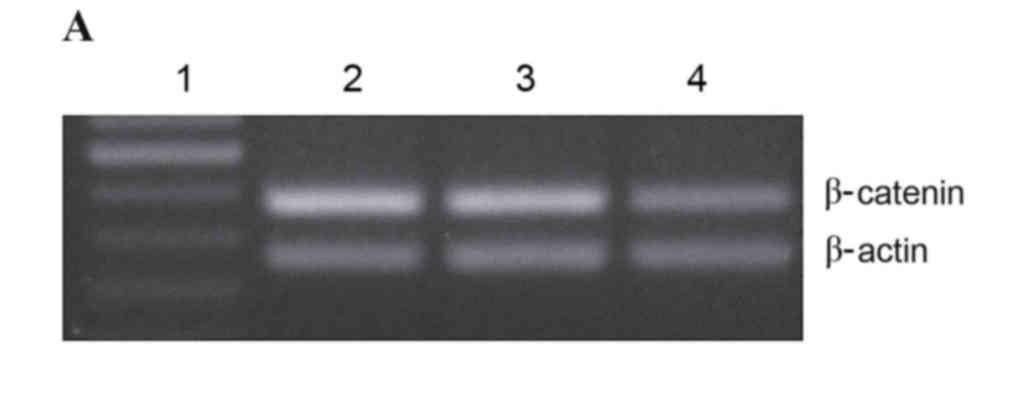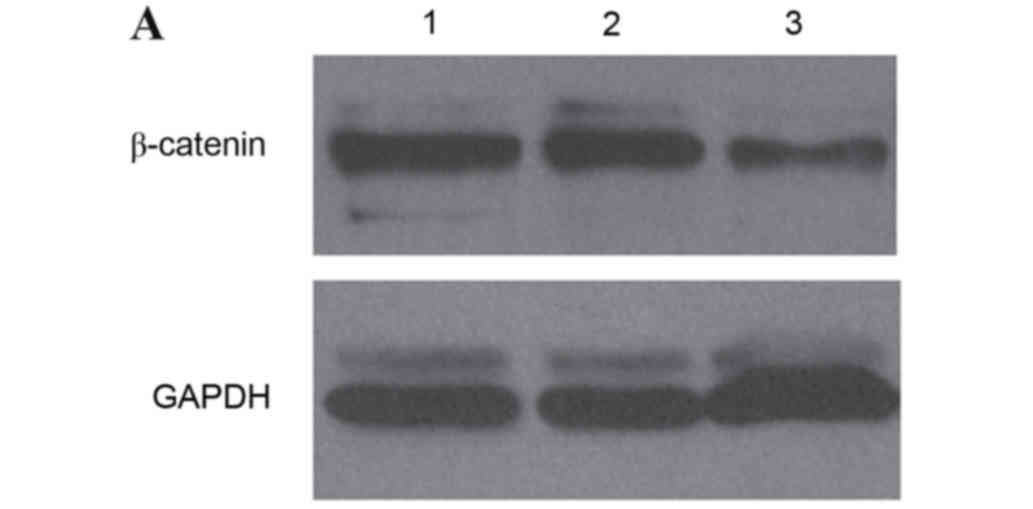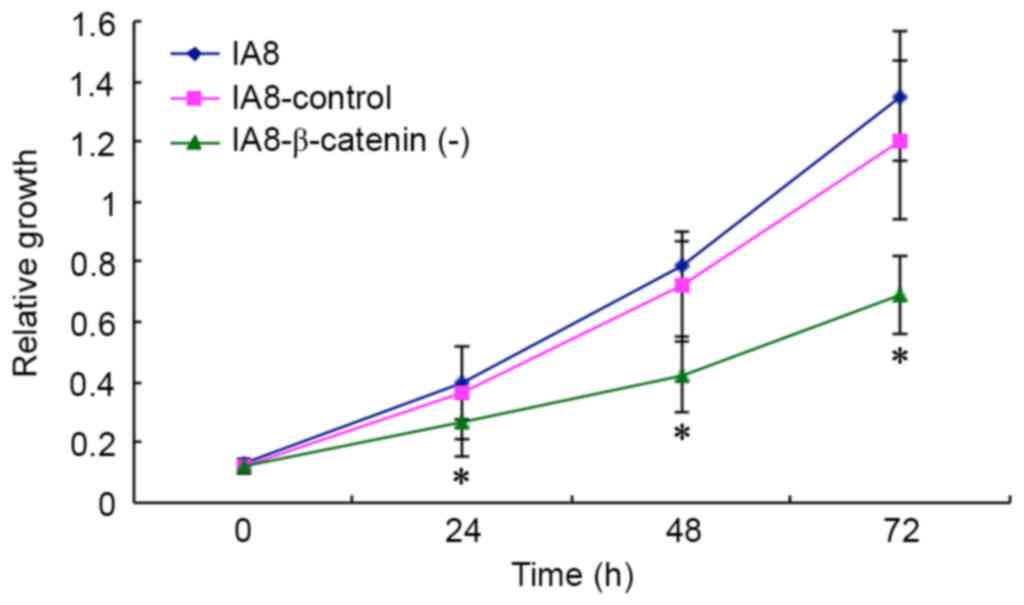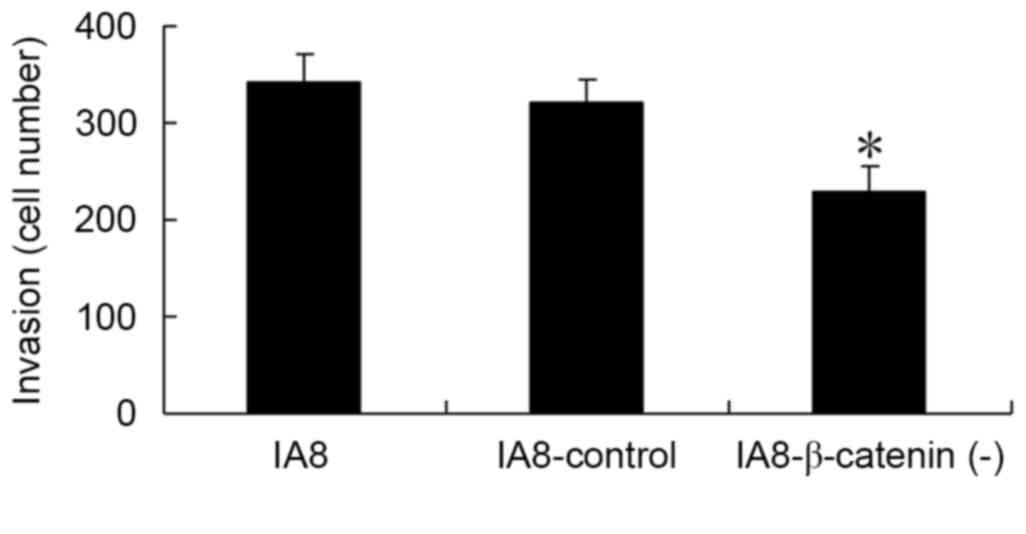Short hairpin RNA directed against β-catenin inhibits prostate cancer growth and invasion in vitro
- Authors:
- Published online on: December 22, 2016 https://doi.org/10.3892/mmr.2016.6067
- Pages: 819-824
Abstract
Introduction
PCa is the second most frequent cause of cancer-associated mortality in males in the USA (1). Various growth factors and cytokines have been reported to be associated with the progress of PCa; however, the exact underlying molecular mechanism of PCa development and progression remains to be fully elucidated.
The Wnt/β-catenin signaling pathway regulates pattern formation during embryogenesis and tumor progression. This signaling pathway activates various distinct intracellular pathways, which are involved in the proliferation, differentiation and polarity of cells. Aberrant activation of the Wnt/β-catenin signaling pathway has been associated with tumor development and metastasis in numerous types of cancer (2–4).
During epithelial mesenchymal transition (EMT), epithelial cells alter morphologically, resulting in a loss of polarity and cell-to-cell contact. It has previously been demonstrated have indicated that during tumor progression, EMT is crucial for the invasion and metastasis of tumor cells (5). Our previous study demonstrated that the activation of the Wnt/β-catenin signaling pathway is associated with the process of EMT and its role in the invasion and proliferation of tumor cells (6). The Wnt/β-catenin signaling pathway was involved in EMT of human PCa induced by hypoxia-inducible factor (HIF) 1-α (7). The current hypothesized that the aberrant activation of the Wnt/β-catenin signaling pathway may be involved the proliferation and invasive potency of PCa. The present study aimed to investigate the expression and distribution of β-catenin in different prostate cancer cell lines. It was demonstrated β-catenin acted as an adhesion molecule in the LNCaP and C4-2 cell lines, and as a transcription factor of the Wnt/β-catenin signaling pathway in the IF11-ARCaP and IA8-ARCaP cell lines. The results of the present study suggested that the aberrant activation of the Wnt/β-catenin signaling pathway in IA8-ARCaP and IF11-ARCaP may be responsible for their high invasive potency.
RNA interference (RNAi) specifically inhibits the transcription of target genes, thus, reducing the corresponding protein levels, and has a high efficiency and specificity. In the present study, small hairpin (shRNA) targeting β-catenin was used to investigate the role of the Wnt/β-catenin signaling pathway in human PCa cells in vitro.
Materials and methods
Cell culture and plasmids
PC-3, LNCaP, C4-2, IA8-ARCaP and IF11-ARCaP human PCa cell lines were obtained from Professor Dalin He, Xi'an Jiaotong University (Xi'an, China). PC-3 cell lines were cultured in Dulbecco's modified Eagle's medium (DMEM), supplemented with 10% fetal bovine serum (FBS), 100 U/ml penicillin and 100 mg/ml streptomycin. LNCaP, C4-2, IA8-ARCaP and IF11-ARCaP were cultured in RPMI-1640 medium supplemented with 10% FBS, 100 U/ml penicillin and 100 mg/ml streptomycin. DMEM and RPMI-1640 medium were purchased from Hyclone (GE Healthcare Life Sciences, Logan, UT, USA), and FBS was purchased from Gibco (Thermo Fisher Scientific, Inc., Waltham, MA, USA). β-catenin shRNA was constructed according to the protocol described in our previous study (7). Based on the vector sequence, the β-catenin shRNA target sequence and a sh-Control sequence (listed in Table I) were synthesized by Sunbiotech (Beijing, China). IA8-ARCaP cells were transfected with β-catenin shRNA using Lipofectamine 2000™ (Invitrogen; Thermo Fisher Scientific, Inc.) according to the manufacturer's protocol.
Western blotting
Total protein was isolated from cultured cells using 300 ml ice cold lysis buffer containing 1% NP-40, 50 mmol/l Tris (pH 7.4), 150 mmol/l NaCl, 0.1% sodium dodceyl sulfate, 0.5% deoxycholate, 200 mg/ml phenylmethanesulfonyl fluoride and 50 mg/ml aprotinin. Insoluble materials were removed by ultracentrifugation at 15,000 × g for 30 min at 4°C. The concentration of the extracted protein was measured spectrophotometrically with Coomassie G-250. Total protein (50 µg) was loaded in each lane and resolved on a denaturing 12% SDS-PAGE gel. The proteins were transferred onto polyvinylidene fluoride membranes (PVDF) using a wet transfer method following polyacrylamide gel electrophoresis, then blocked with 3% bovine serum albumin (Santa Cruz Biotechnology, Inc., Dallas, TX, USA) for 1 h at room temperature and washed with Tris-buffered saline and Tween-20 three times. Antibodies specific for β-catenin (mouse anti-human IgG; 1:500; cat. no. sc-7963) and GAPDH (mouse anti-human IgG; 1:10,000; cat. no. sc-47724) were used to probe membranes, followed by peroxidase-conjugated secondary antibodies (goat anti-mouse IgG; 1:5,000; cat. no. sc-3697) and enhanced chemiluminescence detection (Sigma-Aldrich; Merck Millipore, Darmstadt, Germany). All primary antibodies were obtained from Santa Cruz Biotechnology, Inc. For quantification of band intensity, appropriate films were scanned and band densities were determined using Quantity One software (version 4.6.6; Bio-Rad Laboratories, Inc., Hercules, CA, USA), normalized against GAPDH, and presented as a ratio of control.
Reverse transcription-polymerase chain reaction (RT-PCR)
Total RNA was extracted from the cell lines at 80–90% confluence using TRIzol® (Invitrogen; Thermo Fisher Scientific, Inc.). RNA (1 µg) was reverse transcribed using a RevertAid First Strand cDNA Synthesis kit (Fermentas; Thermo Fisher Scientific, Inc.). Amplification of 2 µl cDNA was performed using Taq polymerase (Takara Bio, Inc., Otsu, Japan) with specific primers for β-catenin and β-actin (Table II). All primers were obtained from Sunbiotech. All PCR reactions were initiated with an incubation at 94°C for 2 min, followed by 29 cycles of 94°C for 30 sec, 58°C for 30 sec and 72°C for 2 min. Reactions were finished with a 72°C, 10 min extension step. PCR products were visualized by electrophoresis on 1.2% agarose gels and quantified with Quantity One analyzing software (version 4.6.6), normalized against β-actin, and presented as a ratio of control. All assays were performed at least 3 times.
Indirect immunofluorescence
To detect the expression and distribution of β-catenin, PCa cells were fixed in 10% paraformaldehyde for 30 min and blocked with goat serum (Santa Cruz Biotechnology, Inc.) for 30 min. Cells were then incubated at 37°C for 1 h with a mouse anti-human β-catenin monoclonal antibody (1:200; Santa Cruz Biotechnology, Inc.; sc-7963). Following three washes with PBS, cells were incubated with a fluorescence isothiocyanate-conjugated goat anti-mouse antibody (1:100; Santa Cruz Biotechnology, Inc.; sc-3692) at 37°C for 1 h. The fluorescence staining intensity and intracellular location were examined by fluorescence microscopy.
MTT assay
The MTT assay was used to determine the proliferation of human PCa cells. PCa cells were seeded in 96-well plates and transfected with β-catenin shRNA. At various time points (24, 48 and 72 h), 50 ml 2.5 ng/ml thiazolyl blue tetrazolium bromide (MTT) solution was added into the cell culture plate and incubated with cells for an additional 4 h. The media was collected separately from each chamber, and cell-associated MTT crystal was dissolved separately in 15 µl/well dimethyl sulfoxide on a shaker at room temperature. Absorbance at a wavelength of 570 nm (proportional to viable cell number) was subsequently measured using a multiplate reader (Bio-Rad Laboratories, Inc.).
Matrigel Transwell assay
Transwell polycarbonate filters (8-mm pore size; EMD Millipore, Billerica, MA, USA) were coated with 50 ml Matrigel (1:5; Sigma-Aldrich; Merck Millipore) in serum-free medium and air-dried for 12 h. Following this, 1×105 cells in serum-free RPMI-1640 were seeded into the upper chamber and 1 ml RPMI-1640 with 20% FBS was added to the lower chamber. Human PCa cells: IA8-ARCaP cells, IA8-β-catenin, IA8-ARCaP cells transfected with β-catenin shRNA and IA8-shControl (IA8-ARCaP cells transfected with β-catenin sh-Control plasmid) were seeded into the upper chamber and allowed to migrate in a 5% CO2 incubator at 37°C for 48 h. Following incubation, a cotton swab was used to remove cells on the upper surface, and any invaded cells attached to the lower surface of the membrane were subsequently fixed with 4% paraformaldehyde and visualized with Giemsa stain (1:100) for 2 h. Cell numbers were counted under a light microscope in 3 random microscopic fields (magnification, ×10) per membrane.
Statistical analysis
Data are presented as the mean ± standard deviation. All data analyses were performed using SPSS software version 13.0 for Windows (SPSS, Inc., Chicago, IL, USA). One-way analysis of variance (ANOVA) and independent-samples t-tests were conducted. Tukey's test was used for post hoc test following the ANOVA. All experiments were performed at least three times with similar results. P<0.05 was considered to indicate a statistically significant difference.
Results
Expression and distribution of β-catenin in different PCa cell lines
β-catenin is a multifunctional protein involved in two processes, cell-to-cell adhesion and the Wnt/β-catenin signaling pathway. To investigate the functional activities of the Wnt/β-catenin signaling pathway in different PCa cells, the present study performed indirect immunofluorescence to detect the expression and distribution of β-catenin protein in PC-3, LNCaP, C4-2, IA8-ARCaP and IF11-ARCaP cell lines.
As presented in Fig. 1, there were marked differences in the expression and distribution of β-catenin between these cell lines. β-catenin was observed in the cytoplasm and nuclei of IA8-ARCaP and IF11-ARCaP cells, whereas it appeared to be present in the membrane of LNCaP and C4-2 cells. There was low expression of β-catenin in the PC-3 cell line. Therefore, β-catenin may act as an adhesion molecule in the LNCaP and C4-2 cell lines, and as a transcription factor of the Wnt/β-catenin signaling pathway in the IF11-ARCaP and IA8-ARCaP cell lines. This data indicated that the functional activity of Wnt/β-catenin signaling pathway in IF11-ARCaP and IA8-ARCaP cells was greater compared with PC-3, LNCaP and C4-2 cells. IA8-ARCaP was therefore used as the cell model to further investigate the role of the Wnt/β-catenin signaling pathway in PCa.
Inhibition of mRNA expression by β-catenin shRNA
Our previous study successfully constructed β-catenin shRNA using gene recombination technology, which significantly decreased the expression of β-catenin in HEK-293 cell lines (6). In the present study, the effects of β-catenin shRNA on the expression of β-catenin mRNA in IA8-ARCaP cell lines were investigated. Fig. 2A reveals the levels of β-catenin mRNA in IA8, IA8-shControl and IA8/β-catenin(−) cell lines, as measured by RT-PCR. Statistical analysis demonstrated that the β-catenin mRNA expression levels in the IA8/β-catenin(−) cell line was significantly downregulated compared with IA8 cells (P=0.002; Fig. 2B). There was no significant difference between the IA8-shControl and IA8 groups.
Inhibition of β-catenin protein expression by β-catenin shRNA
To further investigate the inhibitory effects of β-catenin shRNA on the Wnt/β-catenin signaling pathway, the present study detected the expression of β-catenin protein using western blot analysis. The level of β-catenin protein in IA8, IA8-shControl and IA8/β-catenin(−) cell lines is presented in Fig. 3A. Statistical analysis revealed that the protein expression levels of β-catenin in IA8/β-catenin(−) was significantly decreased compared with IA8 and IA8-shControl group (P=0.029; Fig. 3B). There was no significant difference between the IA8-shControl and IA8 groups.
β-catenin regulates cell proliferation
As malignancy is associated with increasing cancer cell proliferation and invasion, the present study investigated the effect of β-catenin knockdown on proliferation in IA8-ARCaP cell lines. The growth potency of IA8, IA8-β-catenin(−) and IA8-shControl cells were assessed by MTT assay. As presented in Fig. 4, IA8-β-catenin(−) cells exhibited a reduced growth potency compared with IA8-shControl and IA8 cells (P=0.479 at 24 h, P=0.037 at 48 h, P=0.020 at 72 h), suggesting that β-catenin shRNA had an inhibitory effect on the proliferation of the IA8-ARCaP cell line. Suppressing the activity of the Wnt/β-catenin signaling pathway via β-catenin shRNA resulted in growth inhibition of IA8-ARCaP cells in vitro.
β-catenin regulates cell invasion
To further examine the role of the Wnt/β-catenin signaling pathway in cell invasion of human PCa cells, a Matrigel Transwell assay was performed in vitro. The IA8, IA8/β-catenin(−) and IA8-shControl cells were seeded into the upper chambers and 1 ml RPMI-1640 containing 20% FBS was added to the lower chambers. Cells were allowed to migrate for 48 h. As presented in Fig. 5, the number of invading cells in the IA8/β-catenin(−) group was significantly reduced compared with the IA8 and IA8-shControl groups (P=0.002). The results of the Matrigel Transwell assay demonstrated that inhibition of the Wnt/β-catenin signaling pathway via β-catenin shRNA may result in an inhibition of PCa cell invasion in vitro.
Discussion
β-catenin exhibits a dual function in epithelial cells, depending on the intracellular localization. At the plasma membrane, β-catenin is a constituent of adherens junctions, and aids in cell-to-cell adhesion via binding to E-cadherin, and along with α-catenin to the actin cytoskeleton. In addition, β-catenin acts as a key component of the Wnt/β-catenin signaling cascade in the nucleus. Wnt protein binding to the seven-pass transmembrane receptors known as Frizzled proteins activates the signaling pathway, leading to β-catenin stabilization in the cytoplasm. Stabilized β-catenin subsequently translocates to the nucleus, where it associates with T cell factor/lymphoid enhancer factor-1 and promotes specific gene expression. Multiple key oncogenic proteins, including c-Myc, cyclin D1 and cyclooxyenase-2 have been reported to be regulated by the Wnt/β-catenin signaling pathway (8).
The aberrant activation of the Wnt/β-catenin signaling pathway in premalignant and malignant cells results in uncontrolled cell proliferation, growth and survival of cancer cells, and therefore cancer progression. The Wnt/β-catenin signaling pathway is a direct driver of thyroid transcription factor-1 expression, which is a tissue-specific transcription factor essential for thyroid differentiation (9). Dickkopf-related protein-1 (DKK-1), a secreted protein that binds to low density lipoprotein-related receptors 5/6, blocks Wnt-1 protein signaling. Accumulation of DKK1 and cytoplasmic/nuclear β-catenin in triple negative breast cancers is indicative of poor prognosis. DKK1 expression alone or in conjunction with β-catenin may identify patients who may benefit from early systemic treatment (10). In addition, the canonical Wnt/β-catenin signaling pathway regulates self-renewal of cancer stem cells and drug resistance of cancer cells (11,12).
Previous studies have suggested that the Wnt/β-catenin signaling pathway may be important in PCa. Chen et al (4) demonstrated that high levels of Wnt-1 and β-catenin expression were associated with advanced, metastatic, hormone-refractory PCa, and may serve as biomarkers of disease progression. Another study indicated that promoting Wnt/β-catenin activity via blocking DKK-1 promoted osteoblastic activity in osteolytic PC-3 cells, which suggested that the Wnt/β-catenin signaling pathway contributed to the osteoblastic phenotype of PCa cell bone metastasis (13).
EMT is important for cancer growth and invasion. Our previous study demonstrated that the Wnt/β-catenin signaling pathway is involved in EMT in human PCa and may be induced by HIF-1α (5). In the current study, the role of the Wnt/β-catenin signaling pathway in human PCa growth and invasion was investigated. Indirect immunofluorescence was used to detect the expression and distribution of β-catenin, the key component of the Wnt/β-catenin signaling pathway in different human PCa cell lines.
The results of the present study indicated that in the LNCaP and C4-2 cell lines, β-catenin localized in the membrane, whereas in the IA8-ARCaP and IF11-ARCaP cell lines, it was localized in the cytoplasm and nucleus. There was low expression of β-catenin in the PC-3 cell line. The EMT-positive cell lines IA8-ARCaP and IF11-ARCaP exhibited a greater level of cytoplasmic and nuclear β-catenin compared with the EMT-negative cell lines PC-3, LNCaP and C4-2. The activity of the Wnt/β-catenin signaling pathway in the more invasive PCa cells IA8-ARCaP and IF11-ARCaP was markedly greater compared with LNCaP and C4-2 cells. IA8-ARCaP and IF11-ARCaP were established from the ascites of a patient with widely disseminated disease that represented a lethal form of human PCa with the ability to invade and metastasize aggressively to bone and soft tissue (14). The results of the present study suggested that the high functional activity of the Wnt/β-catenin signaling pathway in IA8-ARCaP and IF11-ARCaP may be responsible for their high invasive potency.
RNA interference is the process of post-transcriptional, sequence-specific gene silencing in plants and animals, which was first introduced by Fire et al (15) in 1998, via experimentation in Caenorhabditis elegans. The process is initiated by shRNA homologous in sequence to the particular gene to be silenced. RNA interference is now a tool extensively employed in genetic engineering as a simple and effective gene knockdown technique. shRNA is an artificial RNA molecule with a tight hairpin turn that may be used to silence target gene expression via RNAi. shRNA is an advantageous mediator of RNAi in that it has a relatively low rate of degradation and turnover (15,16). To further investigate the role of the Wnt/β-catenin signaling pathway in PCa cells, β-catenin shRNA was used to suppress the activity of the Wnt/β-catenin signaling pathway in IA8-ARCaP cell lines. The results demonstrated that the β-catenin-specific shRNA significantly suppressed the mRNA and protein expression levels of β-catenin, confirming that β-catenin shRNA may significantly inhibit the activity of the Wnt/β-catenin signaling pathway.
As malignancy has been associated with increased cancer cell proliferation and invasion, the present study investigated the effects of β-catenin shRNA on proliferation and invasion. An MTT assay indicated that knockdown of β-catenin significantly inhibited the proliferation of the IA8-ARCaP cell line. A Matrigel Transwell assay revealed that β-catenin knockdown significantly suppressed the invasive activity of the IA8-ARCaP cell line, which suggested that the Wnt/β-catenin signaling pathway regulated the proliferation and invasion of the IA8-ARCaP cell line. The data indicated that the high functional activity of Wnt/β-catenin signaling in IA8-ARCaP cells was responsible for its high invasive potency.
In conclusion, the present study demonstrated that suppressing the functional activity of the Wnt/β-catenin signaling pathway via β-catenin shRNA results in an inhibition of PCa proliferation and invasion. The results suggested that disrupting the Wnt/β-catenin signaling pathway may represent an opportunity for rational and novel drug design for the treatment and prevention of PCa.
Acknowledgements
The present study was supported by the program of the Science and Technology Development Foundation of Beijing Anzhen Hospital (grant no. 2013Z03).
References
|
Keller ET, Zhang J, Cooper CR, Smith PC, McCauley LK, Pienta KJ and Taichman RS: Prostate carcinoma skeletal metastases: Cross-talk between tumor and bone. Cancer Metastasis Rev. 20:333–349. 2001. View Article : Google Scholar : PubMed/NCBI | |
|
Fodde R and Brabletz T: Wnt/beta-catenin signaling in cancer stemness and malignant behavior. Curr Opin Cell Biol. 19:150–158. 2007. View Article : Google Scholar : PubMed/NCBI | |
|
Guturi KK, Mandal T, Chatterjee A, Sarkar M, Bhattacharya S, Chatterjee U and Ghosh MK: Mechanism of β-catenin-mediated transcriptional regulation of epidermal growth factor receptor expression in glycogen synthase kinase 3 β-inactivated prostate cancer cells. J Biol Chem. 287:18287–18296. 2012. View Article : Google Scholar : PubMed/NCBI | |
|
Chen G, Shukeir N, Potti A, Sircar K, Aprikian A, Goltzman D and Rabbani SA: Up-regulation of Wnt-1 and beta-catenin production in patients with advanced metastatic prostate carcinoma: Potential pathogenetic and prognostic implications. Cancer. 101:1345–1356. 2004. View Article : Google Scholar : PubMed/NCBI | |
|
Luo Y, He DL, Ning L, Shen SL, Li L and Li X: Hypoxia-inducible factor-1alpha induces the epithelial-mesenchymal transition of human prostatecancer cells. Chin Med J (Engl). 119:713–718. 2006.PubMed/NCBI | |
|
Zhao JH, Luo Y, Jiang YG, He DL and Wu CT: Knockdown of β-catenin through shRNA cause a reversal of EMT and metastatic phenotypes induced by HIF-1α. Cancer Invest. 29:377–382. 2011. View Article : Google Scholar : PubMed/NCBI | |
|
Jiang YG, Luo Y, He DL, Li X, Zhang LL, Peng T, Li MC and Lin YH: Role of Wnt/beta-catenin signaling pathway in epithelial-mesenchymal transition of human prostate cancer induced by hypoxia-inducible factor-1alpha. Int J Urol. 14:1034–1039. 2007. View Article : Google Scholar : PubMed/NCBI | |
|
Schmalhofer O, Brabletz S and Brabletz T: E-cadherin, beta-catenin, and ZEB1 in malignant progression of cancer. Cancer Metastasis Rev. 28:151–166. 2009. View Article : Google Scholar : PubMed/NCBI | |
|
Gilbert-Sirieix M, Makoukji J, Kimura S, Talbot M, Caillou B, Massaad C and Massaad-Massade L: Wnt/β-catenin signaling pathway is a direct enhancer of thyroid transcription factor-1 in human papillary thyroid carcinoma cells. PLoS One. 6:e222802011. View Article : Google Scholar : PubMed/NCBI | |
|
Xu WH, Liu ZB, Yang C, Qin W and Shao ZM: Expression of dickkopf-1 and beta-catenin related to the prognosis of breast cancer patients with triple negative phenotype. PLoS One. 7:e376242012. View Article : Google Scholar : PubMed/NCBI | |
|
Cai C and Zhu X: The Wnt/β-catenin pathway regulates self-renewal of cancer stem-like cells in human gastric cancer. Mol Med Report. 5:1191–1196. 2012. | |
|
Cui J, Jiang W, Wang S, Wang L and Xie K: Role of Wnt/β-catenin signaling in drug resistance of pancreatic cancer. Curr Pharm Des. 18:2464–2471. 2012. View Article : Google Scholar : PubMed/NCBI | |
|
Hall CL, Bafico A, Dai J, Aaronson SA and Keller ET: Prostate cancer cells promote osteoblastic bone metastases through Wnts. Cancer Res. 65:7554–7560. 2005.PubMed/NCBI | |
|
Zhau HE, Odero-Marah V, Lue HW, Nomura T, Wang R, Chu G, Liu ZR, Zhou BP, Huang WC and Chung LW: Epithelial to mesenchymal transition (EMT) in human prostate cancer: Lessons learned from ARCaP model. Clin Exp Metastasis. 25:601–610. 2008. View Article : Google Scholar : PubMed/NCBI | |
|
Fire A, Xu S, Montgomery MK, Kostas SA, Driver SE and Mello CC: Potent and specific genetic interference by double-stranded RNA in Caenorhabditis elegans. Nature. 391:806–811. 1998. View Article : Google Scholar : PubMed/NCBI | |
|
Elbashir SM, Harborth J, Lendeckel W, Yalcin A, Weber K and Tuschl T: Duplexes of 21-nucleotide RNAs mediate RNA interference in cultured mammalian cells. Nature. 411:494–498. 2001. View Article : Google Scholar : PubMed/NCBI |














